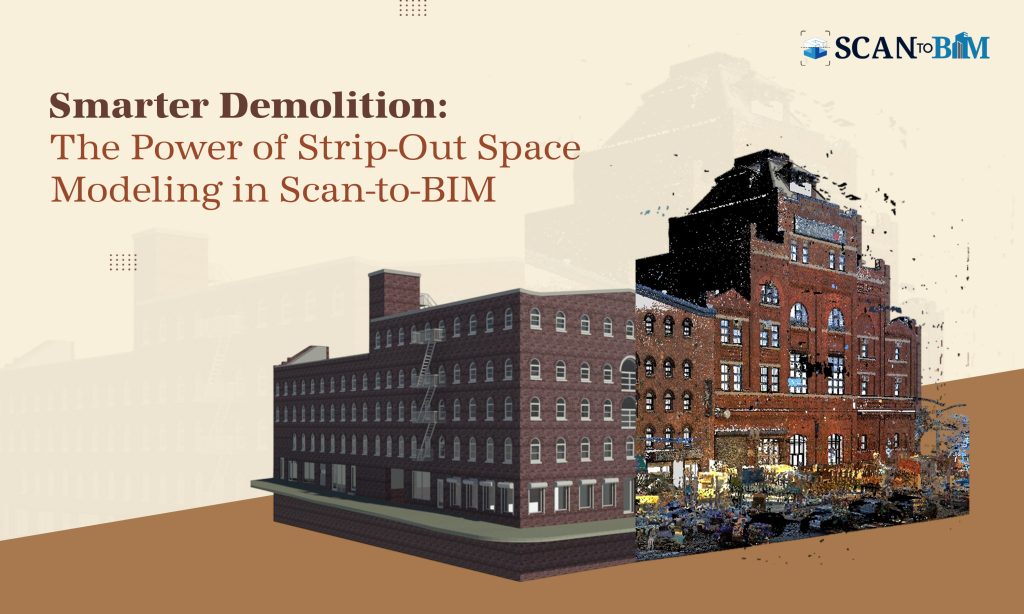
Introduction
Building demolition is a complex process which requires careful planning to ensure the safety, efficiency along with the cost-effectiveness. Traditionally, the demolition projects have faced challenges such as unforeseen structural issues, inaccurate documentation along with the inefficient resource allocation. However, with the advent of BIM Modeling Services, particularly through Scan-to-BIM processes, the industry has been entirely transformed. The key advancement in this domain which is significantly enhancing the demolition efficiency is the strip-out space modeling.
What is Strip-Out Space Modeling?
Strip-out space modeling involves creating the detailed 3D representations of the particular areas designated for a partial or complete removal within a structure. This process however focuses on identifying as well as mapping the non-structural elements like partitions, fixtures, mechanical systems along with the interior finishes that needs to be dismantled before the core demolition begins.
Role of Scan-to-BIM in Strip-Out Space Modeling
Scan-to-BIM is the process of capturing the existing building conditions using the 3D laser scanning technology and then converting this point cloud data into an accurate BIM model. When integrated with the strip-out space modeling, the Scan-to-BIM Services provides precise, data-rich visualizations that helps the demolition teams to plan and execute the projects with greater accuracy.
Benefits of Strip-Out Space Modeling in Demolition Projects
- Improved Planning and Visualization
Strip-out models offer the clear visual insights into the areas that requires removal thereby allowing the project managers to develop the detailed demolition plans. This reduces the guesswork and minimizes the risk of damaging the essential structural components to a greater extent. - Enhanced Safety Measures
By accurately identifying the hazardous materials, load-bearing elements as well as potential risks, the strip-out space modeling supports the implementation of effective safety protocols ultimately protecting the workers along with the surrounding environment. - Optimized Resource Allocation
The detailed models enables the precise estimation of labour, equipment as well as the materials needed for the demolition thereby reducing the wastes and controlling the costs. - Minimized Project Delays
The real-time data from the Scan-to-BIM helps to identify the potential obstacles early in the planning phase hence allowing for the proactive solutions and smoother project execution. - Sustainability and Waste Management
The Strip-out models facilitates the segregation of the recyclable materials and the hazardous waste thereby promoting the environmentally responsible demolition practices.
Applications in Various Demolition Scenarios
- Interior Renovations: In commercial spaces when undergoing the major refurbishments, the strip-out models helps to isolate the non-structural elements while preserving the building’s framework.
- Partial Demolitions: For projects requiring the selective demolition, such as facade removals or structural retrofits, the accuracy of strip-out modeling ensures the precision.
- Complex Industrial Sites: In facilities where there are intricate MEP systems involved, this modeling aids in the safe removal of the outdated equipment without disrupting any of the operational areas.
Challenges and Considerations
Although strip-out space modeling provides several benefits, it also comes with certain challenges:
- Data Accuracy: The quality of the point cloud data directly affects the model’s reliability.
- Technology Integration: Combining of Scan-to-BIM with the traditional demolition workflows always requires specialized skills along with the software compatibility.
- Cost Implications: Initial investments in the scanning equipment as well as the training can be high though they are offset by long-term savings in terms of the project efficiency.
Conclusion
Strip-out space modeling powered by the Scan-to-BIM technology, is transforming the demolition projects by enhancing accuracy, safety and sustainability. As the construction industry is embracing the digital transformation, these advanced modeling techniques will be crucial in optimizing the demolition processes ultimately leading to a more efficient and cost-effective outcomes.